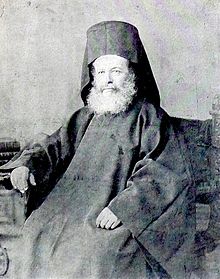|
Germanus V of Constantinople
Germanus V of Constantinople (Greek: Γερμανός; 6 December 1835 – 28 July 1920) was the Ecumenical Patriarch of Constantinople from 28 January 1913 to 25 October 1918. BiographyHe was educated in Jerusalem and Athens before attending the Theological School of Halki. He was elected Metropolitan of Kos (1867), Rhodes (1876–1888), Iraklia (1888–1897) and Chalkedon (1897–1913). On 28 January 1913, he was elected Ecumenical Patriarch of Constantinople. He was one of the pioneers, in the years 1886–1897, of the efforts for the return of the exiled Joachim III of Constantinople. On 7 October 1918, a great rebellion against the Orthodox came and was condemned within the Church of Constantinople. He was forced to resign from the throne on 25 October 1918, retiring to Kadıköy, where he died and was buried in December 1920. He was the last Patriarch who received the imperial veranda, the state's recognition of the Sultan. 1920 encyclicalGermanus V is the author of an encyclical published in 1920 as a milestone for the ecumenical movement. He evokes the notion of a "fraternity of churches" to be created, a "blessed union" of the churches for which he invites different traditions to contribute by engaging in the joint study of the essential questions around the notion of meeting: 1. For the Patriarch, the promotion of contacts between the Churches is the first essential step that must be followed by "the abolition of all mutual mistrust and bitterness" so that "the love [is] revived and strengthened between the churches". 2. It then lists eleven basic points as a working proposal for future collaboration between the churches; Willem Visser 't Hooft, first secretary of the WCC, that the "With its 1920 encyclical, Constantinople rang the bell of our assembling".[1] Notes and references
|
||||||||||||||||||||||||||||
Portal di Ensiklopedia Dunia
